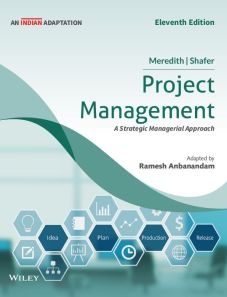Project Management : A Managerial Approach, 11ed (An Indian Adaptation)
ISBN: 9789354641176
556 pages
Publication Year: 2022
For more information write to us at: acadmktg@wiley.com

Description
Project Management: A Managerial Approach, 11th Edition delivers a practical exploration of proven project management techniques and strategies. With a strong emphasis on real-world application and implementation, the book is perfect for managers and business students seeking an instructive leadership resource. It highlights the links between standards and everyday applications and details all Project Management Body of Knowledge concepts.
Preface to the Adapted Edition
Preface to the US Edition
Acknowledgments
1 Projects in Contemporary Organization
1.1 The Definition of a “Project”
1.2 Why Project Management?
1.3 The Project Life Cycle
1.4 Agile Project Management
1.5 The Structure of this Text
Part I: Project Initiation
2 Project Strategy and Selection
2.1 Organizational Project Management and Governance
2.2 Project Selection Models
2.3 Project Portfolio Management (PPM)
3 The Project Manager
3.1 Project Management and the Project Manager
3.2 Special Demands on the Project Manager
3.3 Attributes of Effective Project Managers
3.4 Problems of Cultural Differences
4 Managing for Stakeholders and Resolving Conflicts
4.1 Identifying and Analyzing Stakeholders
4.2 Conflict and the Project Life Cycle
4.3 Dealing with Conflict
4.4 The Nature of Negotiation
4.5 Partnering, Chartering, and Scope Change
5 The Project in the Organizational Structure
5.1 Projects in a Functional Organization
5.2 Projects in a Projectized Organization
5.3 Projects in a Matrixed Organization
5.4 Projects in Composite Organizational Structures
5.5 Selecting a Project Form
5.6 The Project Management Office
5.7 The Project Team
5.8 Human Factors and the Project Team
Part II: Project Planning
6 Activity Planning: Traditional and Agile
6.1 Traditional Project Activity Planning
6.2 Agile Project Planning
6.3 Coordination Through Integration Management
7 Budgeting and Risk Management
7.1 Estimating Project Budgets
7.2 Better Cost Estimating and Bidding
7.3 Project Risk Management
7.4 Quantitative Risk Assessment Methodologies
8 Scheduling
8.1 Background
8.2 Network Techniques: PERT and CPM
8.3 Risk Analysis Using Simulation with Crystal Ball®
8.4 Using These Tools
8.5 Scheduling the Scrum
9 Resource Allocation
9.1 Critical Path Method—Crashing a Project
9.2 The Resource Allocation Problem
9.3 Resource Loading
9.4 Resource Leveling
9.5 Constrained Resource Scheduling
9.6 Goldratt’s Critical Chain
Part III: Project Execution
10 Monitoring and Information Systems
10.1 The Planning–Monitoring–Controlling Cycle
10.2 Information Needs and Reporting
10.3 Earned Value Analysis
10.4 Agile Tools for Tracking Project Progress
11 Project Control
11.1 The Fundamental Purposes of Control
11.2 Three Types of Control Processes
11.3 The Design of Control Systems
11.4 Control of Change and Scope Creep
12 Project Auditing
12.1 Purposes of Evaluation—Goals of the System
12.2 The Project Audit
12.3 The Project Audit Life Cycle
12.4 Some Essentials of an Audit/Evaluation
12.5 Measurement
13 Project Closure and Benefits Realization
13.1 The Varieties of Project Closure
13.2 When to Close a Project
13.3 The Closure Process
13.4 The Final Report—A Project History
13.5 Benefits Realization
13.6 Afterword
Nucor’s Approach to Closure by Addition
Twelve Hospital Handoff Projects
Terminating the Superconducting Super Collider Project
When You Have to Kill a Project
HMT's Closure by Starvation
Questions
Author Index
Subject Index

